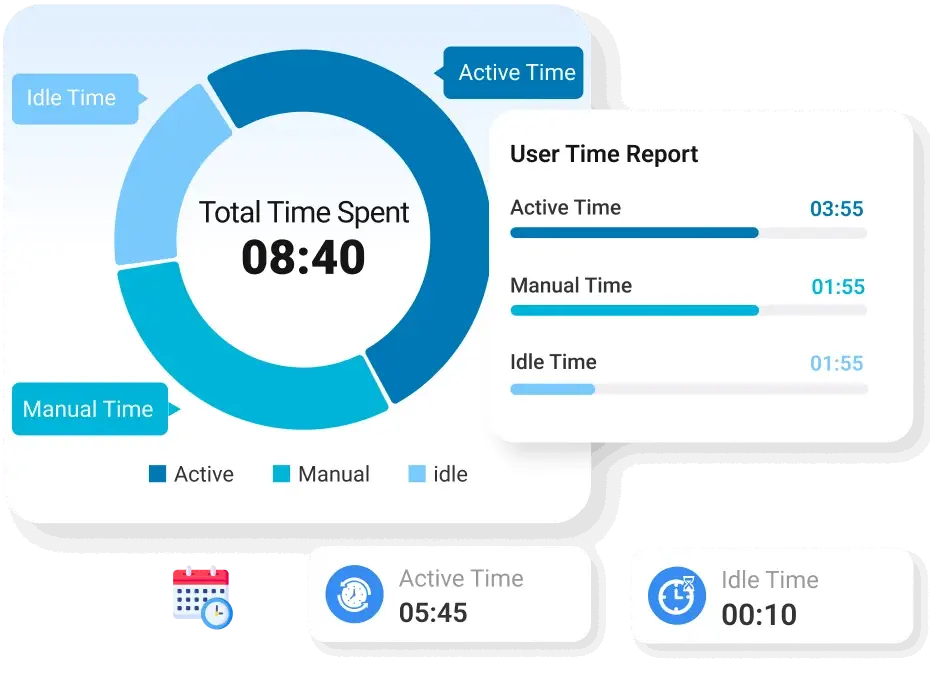
 Tracey Taylor
Tracey Taylor
Oct 24, 2025
Reading Time: 12 Minutes

Your inbox floods. Meetings pile up. Deadlines close in. You switch tasks and by the time the day ends, you’re staring at the screen, wondering, almost guilty, what did I get done?
A to-do list helps… kind of. However, it often makes everything feel busier without giving you control.
This is where time mapping enters the conversation. Instead of an endless list, it gives every part of your day, projects, calls, emails, and even short breaks, a defined place. It’s not simply organization for its own sake; it’s a way of making time visible, so you can catch yourself drifting before the entire day slides off course.
In this blog, we’ll break down how time mapping works and why it could be the game-changer your productivity’s been waiting for.
Time mapping is a time management technique that involves visually creating blocks of time for both work and personal activities to gain a clear picture of how your time is spent. It is used to identify time leaks, adjust and improve productivity, and achieve a better work-life balance.
Unlike a simple to-do list or basic calendar, time mapping provides a detailed, strategic roadmap of your time, allowing you to analyze the quality of your hours and plan more purposefully.

We’ve all had those endless to-do lists that look ambitious in the morning but turn into guilt traps by evening. Time Mapping flips the script by allocating hours to specific priorities.
Here’s why it works:
· Visual clarity: Seeing time blocks makes tasks more tangible.
· Focus protection: A block for “deep work” means no sneaky emails during that slot.
· Boundaries: It stops tasks from sprawling endlessly.
If you’ve ever used apps like Google Calendar, Notion, or Motion, you’ve already tasted a version of Time Mapping. But when used consistently, it becomes less about software and more about a mindset shift.

Why does simply assigning blocks of time seem to make people more productive? It turns out there’s a solid psychological reason. Psychologists call it implementation intention.
So, when someone commits to a specific completion date for a task, it becomes much more likely to occur. Just thinking “I’ll get to it later” usually doesn’t cut it; our brains treat that as optional, and everyone knows how that ends.
Then there’s the Zeigarnik effect. Ever notice how unfinished tasks keep bouncing around in the head, even when trying to focus on something else? That’s the brain nagging.
A time map serves as a mental parking spot, where tasks are scheduled for later, and suddenly, the mind can let go. Knowing it won’t get lost gives a subtle but powerful relief that makes focusing on the next thing much easier.
You don’t need fancy tools to start. A notebook, calendar, or even a phone app will work. The goal is to make your time clear and visible.
1. Define Your Core Categories
Think of your day in four main categories: work, study, family, and rest. These categories are the backbone of your map. If you skip this step, your schedule will appear disorganized and chaotic. Take a moment to be honest about what matters most.
2. Estimate Time Honestly
Most people guess wrong about how long tasks take. If you think emails take 20 minutes, try timing it; you might find it’s closer to 40. Being realistic saves you from frustration and keeps your plan accurate.
3. Block Fixed Commitments First
Start with the things you can’t move, like meetings, school pickups, or doctor’s appointments. These are your anchors. Once they’re in place, it’s easier to see what free time is left for everything else.
4. Layer in Deep Work
Set aside chunks of time for tasks that require focused attention, such as writing, coding, or planning. This is when you do your best to think. Some people use tricks like the Pomodoro timer or background music to stay focused during these blocks.
5. Add Buffers
Life doesn’t always go as planned. Leave 10–15 minutes between tasks to handle delays, take a quick break, or stretch. Without these buffers, even a slight delay can disrupt your entire day.
How does time mapping look in real life? Let’s break it down.
· Remote workers:
Ever feel like work and home have completely blended? A block from 9–11 a.m. for focused tasks, followed by a 30-minute walk, can create a subtle but real boundary. It doesn’t stop distractions entirely, but suddenly there’s a clear line between “work brain” and “home brain.”
· Entrepreneurs:
Founders who need to manage sales calls, product tweaks, and marketing plans all at once. It's for them, without a plan, tasks collide, and nothing moves forward efficiently. Assigning time blocks for each responsibility doesn’t magically reduce stress, but it does make progress visible. Isn’t that better than feeling like everything is spinning out of control?
· Students:
Cramming is stressful. But if Monday evenings are for biology and Wednesday afternoons for history, the load suddenly feels manageable. Sure, life isn’t perfectly predictable; sometimes a last-minute assignment pops up, but even a rough schedule reduces panic and keeps learning on track.
· Parents:
Who hasn’t wished for a little more order in the chaos of homework, dinners, and bedtime routines? Even a loose time map gives slight relief. Setting one hour for homework or bedtime routines frees up mental energy for everything else.
So, what’s gained from mapping time? It’s easy to assume it’s just “being organized,” but the benefits run deeper than that, if done thoughtfully.
First, focus improves. When tasks are assigned specific slots, it’s harder to drift aimlessly between emails, notifications, and random errands. The mind knows when to do something, which reduces the constant tug-of-war for attention. Of course, this isn’t perfect, but having a plan makes it easier to return to work without feeling guilty.
Second, stress decreases. Seeing everything laid out, even if the day is packed, gives a surprising sense of control. Tasks don’t vanish, and the brain can stop fretting about what’s forgotten. Some might argue that strict schedules could feel suffocating, yet even a flexible map brings relief by externalizing the mental load.
Third, productivity becomes more predictable. By measuring the actual time, it takes to complete tasks, adjustments can be made for realistic planning. This prevents overcommitting and helps identify patterns, such as noticing that mornings are better for creative work, while afternoons are better suited for routine tasks.
Finally, time mapping encourages reflection. At the end of the day, it’s possible to see where energy is being spent and where improvements are needed. This isn’t just about efficiency for the sake of efficiency, it’s a tool for understanding personal work habits and making minor, incremental improvements.

Time mapping isn’t a magic fix. So why do so many people stumble when they try it? A few patterns keep showing up.
1. Over-scheduling: Have you ever tried to pack every single hour of your day, thinking it’ll make you more productive? Chances are, it backfires. A jam-packed map leaves no breathing room, and burnout is never far behind. On paper, it looks efficient, but in practice, it can feel more like a trap than a tool.
2. Ignoring energy cycles: Not all hours are equal. If mornings are when focus is sharpest, does it make sense to spend that prime time sorting emails or doing mundane admin tasks? Some tasks demand attention, others don’t; misplacing them can make the whole map less effective.
3. Treating it as rigid: Life rarely follows a perfect plan. Meetings run long, kids interrupt, and emergencies pop up. A map that can’t bend will crack under pressure. Flexibility isn’t cheating; it’s what keeps the system realistic.
So, here’s the bottom line: a time map should guide, not confine. When used thoughtfully, it can reduce stress, protect focus, and stop tasks from slipping through the cracks. But it only works if the schedule respects real life, not the other way around.
While pen and paper still work, digital tools can make time mapping easier by adding reminders, flexibility, and visibility.
· Google Calendar: The classic choice. Color-coded blocks make it simple to see different categories at a glance.
· Notion: Excellent for combining tasks with project notes, so everything lives in one place.
· Motion: AI-powered scheduling that automatically rearranges blocks when life shifts.
· Trello + Calendar Power-Ups: Perfect if you like kanban boards but also want to assign specific time slots.
· StaffViz: Designed for teams, it helps visualize when people are available, track collaborative work blocks, and reduce scheduling chaos. Especially useful for managers or remote teams trying to coordinate without the need for endless back-and-forth.

At first glance, time mapping and time blocking might seem interchangeable, but they’re more like cousins than twins. So, what’s the difference and why does it matter?
|
Feature |
Time Blocking |
Time Mapping |
|
Purpose |
Assigns specific tasks to fixed time slots |
Organizes broader categories of activities across the day or week |
|
Level of Detail |
Task-level, specific (e.g., “Write report 2–4 p.m.”) |
Category-level, flexible (e.g., “Deep Work 2–4 p.m.” covering writing, coding, planning) |
|
Flexibility |
Less flexible; each task has a set time |
More flexible; category allows multiple types of tasks |
|
Best For |
Executing individual tasks efficiently |
Planning overall workflow and balancing priorities |
|
Analogy |
Street-level navigation |
City plan |
Think of it like navigating a city. Time blocking is street-level; you know precisely which turn to take. Time mapping is like a city plan; you see neighborhoods, main roads, and how everything connects. Ignore the city plan, and you might overbuild one area while neglecting another.
In practice, the two work best together. Mapping sets the broad layout of your day or week and blocking fills in the structure.
Yes, teams can gain advantages from time mapping. But how does it function when there are several participants? To facilitate the identification of available individuals, numerous businesses use shared calendars to prearrange appointments.
Tools such as Asana or ClickUp offer direct calendar integration, enhancing transparency and eliminating the need for multiple stages of a campaign, including brainstorming, drafting, editing, and publishing.
Everyone is aware of the project's current stage, which diminishes the frequency of Slack messages asking, "Is this ready yet?" It does more than organize work; it establishes expectations and creates mental space.
Nevertheless, there’s a risk. Could tracking everyone’s time become a form of micromanagement? Definitely.
Here’s the tricky part: time mapping isn’t just about cranking out tasks. It’s also about making room for life. Ever notice how work can quietly creep into every hour if there’s no boundary? That’s where mapping helps.
For example, blocking “family dinner” from 7–8 p.m. three nights a week suddenly makes that time sacred. It’s not optional, it’s scheduled. The invisible priorities of life become visible, and that small act of planning can prevent work from expanding endlessly into personal time.
It can even change the way downtime feels. Watching Netflix or going for a walk doesn’t have to feel like stolen time. When it’s part of a planned block, guilt fades. Could this be one of the simplest ways to strike a balance between work and life? Possibly, though, of course, unexpected events will always disrupt the perfect map. Flexibility remains key.
Ultimately, time mapping isn’t just a productivity hack. It’s a tool for shaping a day that fits both work and life, giving attention to what truly matters without letting either get lost.

Time mapping isn’t a miracle cure, but it does offer a way to take control of time instead of letting it control you. The real value lies in observing how hours are spent, noticing patterns, and making small, intentional choices about where attention is directed.
It’s easy to assume that planning every minute will make life perfect, but that’s rarely the case. Over-scheduling, ignoring energy cycles, or treating the map as rigid can have unintended consequences. The best approach is flexible: map the big picture, block key tasks, but leave room for life’s unpredictability.
Teams can benefit too. Shared maps enhance collaboration, minimize constant checking, and clarify priorities, provided they empower rather than micromanage. And beyond work, time mapping can support balance, helping carve out space for family, hobbies, and rest without guilt.
Ultimately, it’s not about doing more, but about doing what matters, when it matters. Even minor changes, such as mapping a few core blocks each week, can have a profound impact on focus, productivity, and overall well-being. The question isn’t whether time mapping works; it’s whether it can be shaped to fit your life, rather than the other way around.
Enhance team efficiency and collaboration with StaffViz, the ultimate tool for managing remote and hybrid teams.
START FREE TRIAL
Powered by Staffviz